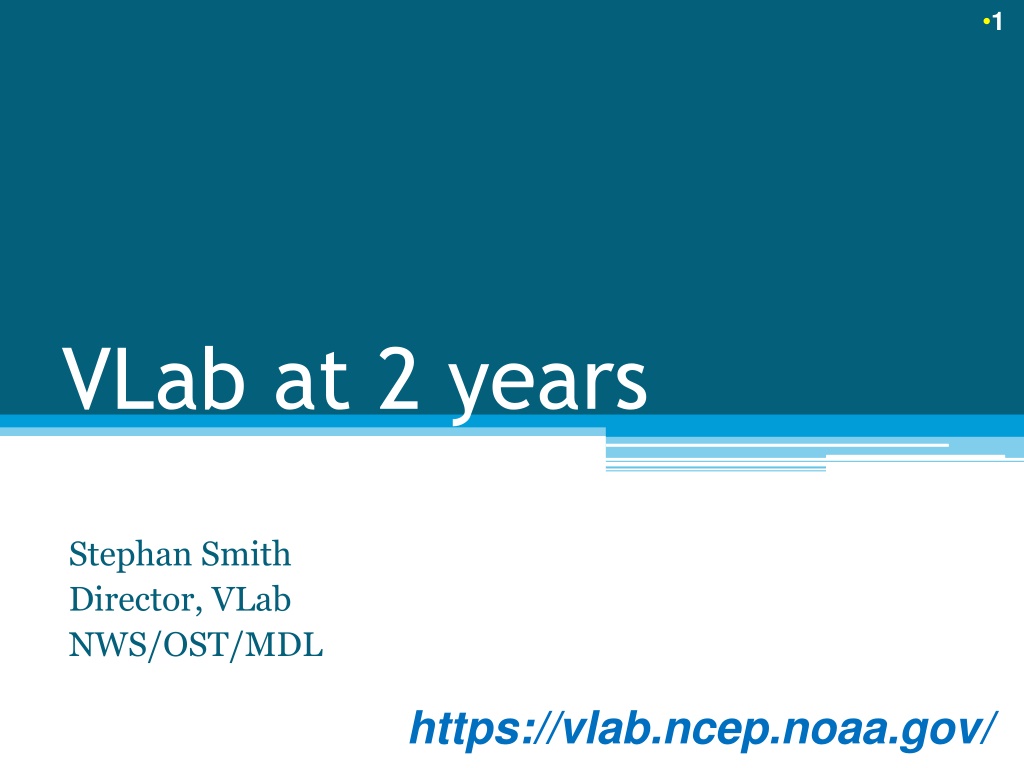
Insight into VLab: Innovating Operations for NOAA
Explore the VLab initiative led by Stephan Smith at NOAA, aiming to manage innovation, streamline operations, and accelerate research transition. The virtual lab components, growth statistics, actual usage data, and notable achievements showcase its vital role in projects like AWIPS, GOES-R, and more. The VLab Adjunct Program and Support Team further enhance its impact.
Download Presentation

Please find below an Image/Link to download the presentation.
The content on the website is provided AS IS for your information and personal use only. It may not be sold, licensed, or shared on other websites without obtaining consent from the author. If you encounter any issues during the download, it is possible that the publisher has removed the file from their server.
You are allowed to download the files provided on this website for personal or commercial use, subject to the condition that they are used lawfully. All files are the property of their respective owners.
The content on the website is provided AS IS for your information and personal use only. It may not be sold, licensed, or shared on other websites without obtaining consent from the author.
E N D
Presentation Transcript
1 VLab at 2 years Stephan Smith Director, VLab NWS/OST/MDL https://vlab.ncep.noaa.gov/
2 The Goal of VLab The Goal of VLab is to manage innovation, streamline Operations to Research (O2R), and accelerate Research to Operations (R2O) in NOAA.
VIRTUAL LAB COMPONENTS Virtual Virtual Lab (VLab) (VLab) Lab Collaboration Collaboration Services Services Development Development Services Services Project Project Mgmt/Issue Mgmt/Issue Tracking Tracking (Redmine) Workflow Communities Communities Blogs Forums Code Review - Gerrit Gerrit Document Libraries Wikis svn Git Continuous Integration Jenkins Jenkins Web Content
Growth of VLab 1600 90 80 1400 70 1200 60 1000 50 800 40 600 30 400 20 10 200 0 0 Communities Projects Collaboration Services Users Development Services Users
5 Growth of VLab
6 VLab Development Services (Redmine): Actual Usage* VLDS April 2014 December 2014 Sessions Users 1,784 344 3,005 802 12.3% New Users 87.7% Returning Users Average Session Duration: 10:30 min 526 Man-hours in December * Google Analytics
7 VLab Collaboration Services (LIFERAY): Actual Usage* VLCS April 2014 December 2014 Sessions Users 1,090 398 2,313 1,031 28.7% New Users 71.3% Returning Users Average Session Duration: 5:08 min 196 Man-hours in December * Google Analytics
8 Achievements 1. AWIPS VLab is now an essential and required component in the transition of research to operations (R2O) for the National Weather Service (NWS) Advanced Weather Interactive Processing System (AWIPS) II system 2. The VLab AWIPS Community is now the official source of AWIPS documentation 3. VLab has been successfully rehosted on NOAA IDP web farm 4. Many important NOAA projects rely on VLab for R2O: e.g., National Blend of Models, GOES-R, Hazards Services, Extra-Tropical Storm Surge, MRMS, MPAR, Impacts Catalog, NOAA Weather Wire, NDFD Verification, Aviation Forecast Verification Tool, and FACETS PHI Tool
9 Achievements 5. VLab Adjunct Program allows field staff to contribute to national R2O projects 6. VLab Support Team provides comprehensive user support M-F during business hours 7. Monthly VLab Focal Point meetings allows users to ask in-depth questions of VLab staff, share best practices and learn of upcoming changes
10 Lessons Learned 1. Easily accessible software code repositories are key to most transition projects. 2. Using the software management (e.g., Gerrit, Jenkins) tools in VLab improves the quality of the code developed. 3. Using VLab reduces direct (e.g., purchasing like COTS tools) as well as indirect (system administration) project transition costs. Applied to hundreds or thousands of projects across NOAA, this represents a significant cost reduction. 4. VLab allows for customized transition solutions which is essential in light of the diversity of NOAA R&D projects and operational systems.
11 Lessons Learned (cont.) 5. There is a significant learning curve for users to become proficient in using the VLab collaboration tools. 6. There is an ongoing need for marketing to potential user groups in NOAA. 7. There is a high demand to open up VLab more to non-NOAA users. 8. Sharing information enhances collaboration and raises all boats. VLab has benefitted from VLab!
12 Lessons Learned (cont.) 9. Establishing a local development environment for AWIPS is still far too problematic. 10. We must improve our expertise in user interface design. 11. There is an ongoing need for user training on VLab. 12. The Google suite of collaboration tools can be effectively integrated/leveraged within VLab. 13. We need to work on building a greater sense of community among VLab users.
13 Upcoming Enhancements 1. Single Sign-on (Google Pass-through)* 2. Closer integration of VLab components (e.g., My Development Projects Portlet, My Issues Portlet, Dynamic Development Projects Portlet) 3. Projects Repository portlet and Ideas Marketplace 4. VLab Trouble-Shooting Forum * Investigating use of OpenID Connect Google is shutting down support for OpenID 2.0 on April 20, 2015
14 On the Horizon 1. Open VLab 2. Enabling HIWPP/NGGFS development 3. Central Development and Testing Environment 4. Migration of AWIPS Software Collaboration Portal to Vlab 5. Customizable VLab Landing pages 6. VLab Subject Matter Experts portlet
15 Questions? Comments?
